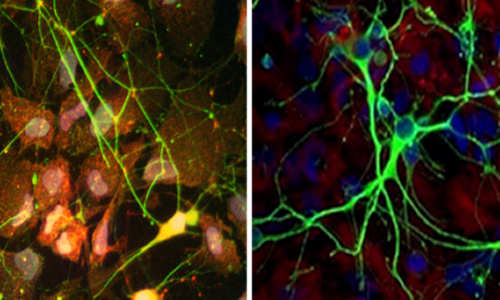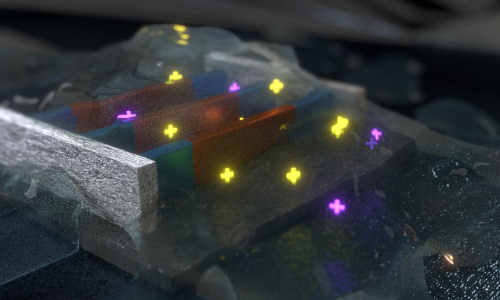Researchers at the University of Milan in Italy have shown that a synthetic protein called AGMA1 has the potential to promote the adhesion of brain cells in a laboratory setting. This could prove helpful in improving cell adhesiveness to biomaterials.
Representative confocal microscopy pictures of primary mixed coculture neurons-astrocytes grown on AGMA1 (Left) and PLL (Rigt). – Scale bar = 25 μm. Photo Credit: Science and Technology of Advanced Materials
Isolating nerve cells from their original organism and culturing them in the laboratory has long been used as a method to study brain metabolism. It has been challenging, however, to provide brain cell cultures with the necessary “adhesion promoters” that facilitate cell attachment, spreading, growth and morphological development.
Improving cell adhesion to biomaterials is also a major challenge in nerve tissue engineering and is crucial for the development of implanted neural prostheses, such as cochlear implants, and biosensors, such as blood glucose biosensors.
Coating the surfaces of negatively charged cell membranes with positively charged synthetic proteins promotes nerve adhesion and extension in laboratory settings. Most synthetic proteins, however, are toxic to living cells and thus need to be washed off before cell suspensions are spread onto a new plate. They are also unsuitable for applications that are used inside a living organism.
Within the central nervous system, extracellular matrix substances such as collagen and laminin promote the regeneration, differentiation, adhesion and migration of nerve fibers.
A protein sequence found in collagen and laminin has been identified as the minimum sequence that can mediate the adhesion of many cell types, including nerve cells.
AGMA1 is a basic synthetic protein that is biocompatible, water soluble, positively charged, and has a protein sequence similar to that found in collagen and laminin. It is much less toxic to living cells than conventionally used synthetic proteins. AGMA1 is also much easier to prepare on a large scale using relatively low-cost materials. As a result it is much cheaper.
University of Milan scientists tested the potential of AGMA1 to promote the adhesion, proliferation, and differentiation of primary brain cells in the laboratory.
Different primary cell types from rat brain were cultured on AGMA1, and the results compared with those of cells cultured under the same conditions on conventional substrates using other commonly used synthetic proteins. All experimental results showed that the performance of AGMA1 in this respect was comparable to that of conventional substrates.
Story Source:
The above story is based on materials provided by National Institute for Materials Science.





